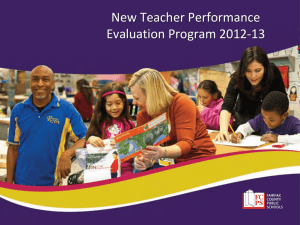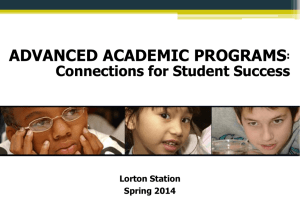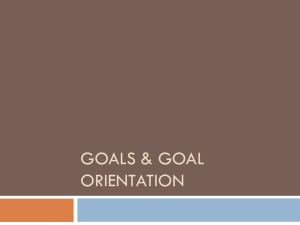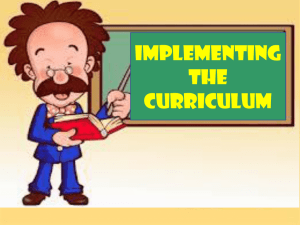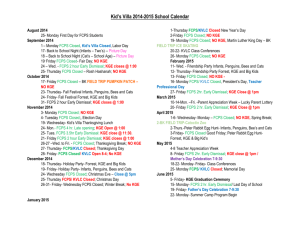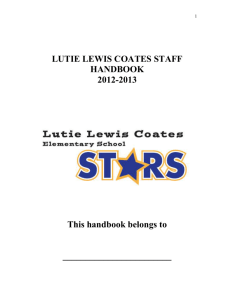Full Day training PPT - Fairfax County Public Schools
advertisement
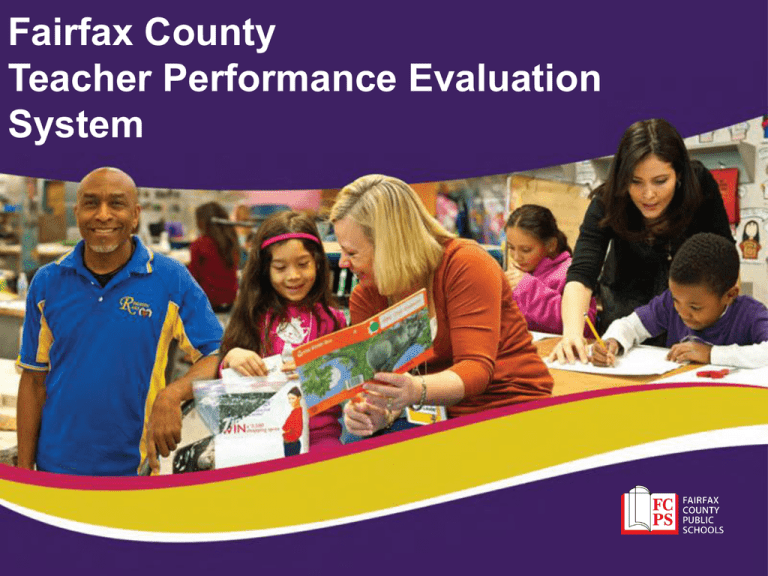
Fairfax County Teacher Performance Evaluation System Norms Support each other in the learning process Monitor our progress Attend fully Respect each others’ view points Take time to reflect Remember our purpose Outcomes Participants will understand: • The reasons for the changes • The Teacher Evaluation Process and Overview of the Handbook • An in depth look at Standard 7: Student & Student Goal Setting Why is change necessary? 4 Three Primary Drivers 1. National Mandates – NCLB and State Waivers 2. Code of Virginia School boards shall develop a procedure for use by division superintendents and principals in evaluating instructional personnel that is appropriate to the tasks performed and addresses, among other things, student academic progress and the skills and knowledge of instructional personnel, including, but not limited to, instructional methodology, classroom management, and subject matter knowledge. Article 2, paragraph 22.1-295 Three Primary Drivers 3. Connections Between Student Success, Teacher Improvement, and Teacher Evaluation “Teachers have the greatest impact on student success.” “Without capable highly effective teachers, in America’s classrooms, no educational reform effort can possibly succeed.” “ Moreover, without highly quality evaluation systems, we cannot know if we have quality teachers.” (Quotes from forward of FCPS Teacher Evaluation Handbook, Dr. James H. Strong , August 2012) Virginia and NCLB Reform • Virginia requests waiver from US Department of Education • Key to VDOE request Implement a New evaluation process that would include rigorous new content standards and assessments to close achievement gaps • FCPS Teacher Evaluation Task Force Formed September 2011 to June 2012 Virginia and NCLB Reform • June 29, 2012 – DOE Waiver: Virginia school divisions will no longer have to meet the arbitrary and unrealistic NCLB benchmarks or AYP • VDOE Mandate - Effective July 1, 2012 All school systems are to implement a new teacher evaluation process – containing seven standards, with Standard 7 - Student Progress weighted 40% “In FCPS all schools will build professional learning communities that employ best practices to raise the bar and close achievement gaps. All educators will use the Program of Studies to ensure all students reach their full potential with an expectation that students will read on grade level and graduate on time.” -Jack D. Dale 8.8.12 Aligning the VDOE Mandate with the FCPS Expectation • Teacher Evaluation Task Force - - - goal to comply with state mandate and customize a new FCPS Teacher Evaluation Program • Development of a NEW Teacher Evaluation Program Handbook • Creation of Teacher Evaluation Training Plan (16,000 teachers and 600+ evaluators) Training Plan Primary Purpose of the FCPS’s Teacher Performance Evaluation Program “To help both teachers and their evaluators collect more comprehensive and accurate assessment data for rating teacher effectiveness and, then to support quality teaching everyday in every classroom.” (Quote from forward of FCPS Teacher Performance Evaluation Handbook, Dr. James H. Strong, August 2012) Take a look at the Crosswalk What are the changes? • • • • • Seven standards instead of five Standard 7 is Student Academic Progress Matrices are used to rate the teacher Four rating levels, as opposed to three A minimum of one formal and three informal/miniobservations • In addition to the goal-setting conference and documentation log, evaluators are required to collect a minimum of four data sources • Final evaluation conference between the evaluator and teacher is required for teachers in their summative evaluation year 15 Cheers and Fears 16 Glossary Break Teacher Performance Standards 1. Professional Knowledge The teacher demonstrates an understanding of the curriculum, subject content, and the developmental needs of students by providing relevant learning experiences. 2. Instructional Planning The teacher plans using the Virginia Standards of Learning, the school’s curriculum, effective strategies, resources, and data to meet the needs of all students. 3. Instructional Delivery The teacher effectively engages students in learning by using a variety of instructional strategies in order to meet individual learning needs. 4. Assessment of and for Student Learning The teacher systematically gathers, analyzes, and uses all relevant data to measure student academic progress, guide instructional content and delivery methods, and provide timely feedback to both students and parents throughout the school year. 5. Learning Environment The teacher uses resources, routines, and procedures to provide a respectful, positive, safe, student-centered environment that is conducive to learning. 6. Professionalism The teacher maintains a commitment to professional ethics, communicates effectively, and takes responsibility for and participates in professional growth that results in enhanced student learning 7. Student Academic Progress The work of the teacher results in acceptable, measurable, and appropriate student academic progress. Main Components Performance Standard Performance Standard 1: Professional Knowledge The teacher demonstrates an understanding of the curriculum, subject content, and the developmental needs of students by providing relevant learning experiences. Key Elements Examples may include, but are not limited to: Key Elements The teacher: 1.1 Demonstrates a comprehensive understanding of subject content and curriculum standards. 1.2 Demonstrates knowledge of best practices. 1.3 Knows how to differentiate to make subject content relevant, challenging, and meaningful for all students. 1.4 Establishes instructional goals that demonstrate an accurate knowledge of students and assigned subject content. Performance Matrix for Professional Knowledge Highly Effective Effective Developing OR Needs Improvement Ineffective Performance Matrix Is expert in the subject area and has an understanding of current research in child development and how students learn. Knows the subject matter well and has a good grasp of child development and how students learn. Is somewhat familiar with the subject and has a few ideas of ways students develop and learn. Has little familiarity with the subject matter and few ideas on how to teach it and how students learn. Designs highly relevant lessons that will challenge and motivate all students and highly engage active learning. Designs lessons that are relevant, motivating, and likely to engage students in active learning. Plans lessons that will catch some students’ interest and perhaps get a discussion going. Plans lessons with very little likelihood of motivating or involving students. Designs lessons that break down Designs lessons that target several Plans lessons with some thought Plans lessons with no complex tasks and address all learning needs, styles, and interests. about how to accommodate student differentiation. learning needs, styles, and interests. needs. Projects high expectations and determination and convinces all students that they will master the material. Conveys to students: This is important, you can do it, and I’m not going to give up on you. Tells students that the subject matter is important and they need to work hard. Actively embeds a “growth” mindset so that students take risks, learn from mistakes, and understand that effective effort leads to achievement. Conveys to students that effective effort, not innate ability, is the key. Doesn’t counteract student Communicates a “fixed” mindset misconceptions about innate ability. about ability: some students have it, some don’t. Continually grabs student interest and makes connections to prior knowledge, experience, and reading. Activates student prior knowledge and hooks their interest in each unit and lesson. Is only sometimes successful in making the subject interesting and relating it to things students already know. Gives up on some students. Rarely hooks student interest or makes connections to their lives. Underline Key Terms in the Rating Scale Category Description Definition Highly Effective The teacher maintains performance, accomplishments, and behaviors that consistently and considerably surpass the established standard. • Sustains high performance over period of time • Behaviors have strong positive impact on learners and school climate • Serves as role model to others Effective The teacher meets the standard in a manner that is consistent with the school’s mission and goals. • Meets the requirements contained in job description as expressed in evaluation criteria • Behaviors have positive impact on learners and school climate • Willing to learn and apply new skills Developing OR Needs Improvement The teacher often performs below the established standard or in a manner that is inconsistent with the school’s missions and goals. • Requires support in meeting the standards • Results in less than quality work performance • Leads to areas for teacher improvement being jointly identified and planned between teacher and evaluator Ineffective The teacher consistently performs below the established standards or in a manner that is inconsistent with the school’s missions and goals. • Results in minimal student learning • May result in employee not being recommended for continued employment Summative Ratings Standards 1-6 Teacher Practice 60% Teacher Evaluation 100% Standard 7 Student Academic Progress 40% Student achievement goal setting Other measures of student academic progress The first six standards impact student progress I. Professional Knowledge II. Instructional Planning VI. Professionalism VII. Student Academic Progress III. Instructional Delivery V. Learning Environment IV. Assessment of and for Student Learning Turn and Talk How do you see the connection or impact of Standards 1- 6 on Standard 7? Questions Standard 7: Student Academic Progress The work of the teacher results in acceptable, measurable, and appropriate student academic progress. Standard 7: Student Academic Progress Key Elements Examples may include, but are not limited to: The teacher: • 7.1 In collaboration with the evaluator, uses multiple measures of student learning to set goals that are strategic and specific, measurable, attainable, results-oriented, time-bound, and have rigor. • 7.2 In collaboration with the evaluator, reflects on student progress over time, using documented evidence to demonstrate student growth, adjust practice, and meet goals. Standard 7: Matrix Highly Effective Effective Developing OR Needs Improvement Ineffective Generates high level of student academic progress with all populations of learners Generates appropriate level of student academic progress with all populations of learners Generates appropriate Generates low level of level of student academic student academic progress with only some progress populations of learners At least ninety percent of students meet and/or exceed SMARTR goal At least eighty percent of students meet and/or exceed SMARTR goal At least fifty percent of students meet and/or exceed SMARTR goal Less than fifty percent of students meet and/or exceed SMARTR goal Standard 7: Student Academic Progress – Include multiple measures of student academic progress – Include Student Growth Percentiles (SGPs) when available and appropriate (Not being used in FCPS for 2012-13) – Use student achievement goal setting or other measures of student progress – Account for 40% of the Teacher’s Summative Performance Evaluation Source: 2011 Guidelines for Uniform Performance Standards and Evaluation Criteria for Teachers What are the Purposes of Student Achievement Goal Setting? Focus on student results Explicitly connect teaching and learning Improve instructional practices and teacher performance Tool for school improvement Student Achievement Goal Setting • Student Achievement Goal Setting used for both teachers of tested and non-tested grades and subjects • Percentage of Standard 7 weight is 40% • Appropriate measures of academic progress are determined • During first month of school, all teachers will work collaboratively with grade level or content team to create a SMARTR goal. Each teacher will fine-tune the goal to reflect the needs of their respective learners The goal will be approved by evaluator by the end of October • Midyear review of student progress goal and modify strategies with administrator (summative evaluation year only) • End-of-year review of goal attainment (all teachers) • Quality of the goals and their attainment provide an important data source for evaluation What is the Student Achievement Goal Setting Process? Step 1: Determine needs Step 2: Create specific learning goals based on preassessment Step 3: Create and implement teaching and learning strategies Step 4: Monitor student progress through ongoing formative assessment Step 5: Determine whether the students achieved the goal What Makes Goals SMARTR? • • • • • • Strategic & Specific Measureable Attainable Results-Oriented Time-bound Rigorous STRATEGIC & SPECIFIC Aligned with the schoolwide goal and focused on specific students MEASURABLE Qualitative, quantitative, observable, consistent measure for grade level or content area ATTAINABLE Doable, yet challenging RESULTS-ORIENTED Identifies specific outcomes or targets for student achievement TIMEBOUND Establishes a sense of priority or urgency for goal attainment RIGOROUS Has an appropriate level of rigor to demonstrate mastery of learning objective Goldilocks Principle Progress (Growth) vs. Achievement Goals PROGRESS ACHIEVEMENT Students will score 50% greater on the post-test than on the pre-test. OR Students will increase their performance by 1 performance level on the rubric. 80% of students will achieve a score of 80% or higher. Benefits and Challenges • What are the benefits and challenges to measuring progress? • What are the benefits and challenges to measuring achievement? Progress Benefits: • Takes into account the diversity of learners • Shows growth even when students haven’t made a particular cut score Challenges: • Requires more time to document • If enough progress is made, students will never achieve at high levels Achievement Benefits: • Ensures that all students are receiving a high level of education • Students need prerequisite knowledge before moving to the next level Challenges: • Not all students start in the same place • Not all students learn at the same rates Handbook Overview Lunch 47 Questions What is the Student Achievement Goal Setting Process? Step 1: Determine needs Step 2: Create specific learning goals based on preassessment Step 3: Create and implement teaching and learning strategies Step 4: Monitor student progress through ongoing formative assessment Step 5: Determine whether the students achieved the goal SIP CT CT CT Individual Teacher Goal Individual Teacher Goal Individual Teacher Goal Individual Teacher Goal Individual Teacher Goal Individual Teacher Goal Individual Teacher Goal Individual Teacher Goal Individual Teacher Goal Sample Goal Setting for Student Progress Form I. Setting (Describe the population and special learning circumstances) II. Content/Subject/Field Area (The area/topic addressed based on learner achievement, data analysis, or observational data) III. Baseline Data (What is shown by the current data?) Data attached IV. Goal Statement (Describe what you want learners/program to accomplish) V. Means for Attaining Goal (Strategies used to accomplish the goal) Strategy Evidence Abbreviated for training purposes Target Date Professional’s Name: Teacher H Worksite Yourtown High School Job Title: English Teacher School Year 2012- 13 I. Setting (Describe the population and special learning circumstances) This goal is based on one of my English Grade 10 classes which has 30 students. Five of the students qualify for special services and have IEPs. II. Content/Subject/Field Area (The area/topic addressed is based on learner achievement, data analysis, or observational data) I will focus on essay writing. Our school is focusing on increasing writing scores. Over the past three years, the percent passing has been 74 percent 78 percent, and 81 percent. We are seeing a positive trend in writing and will continue to focus on this area. III. Baseline Data (What does the current data show?) I administered a writing prompt at the beginning of the year and used a four-point rubric to score the responses, scoring both according to critical element and holistically. The data indicate that six students scored at performance level 1, 11 students scored at performance level 2, ten students scored at performance level 3, and three students scored at performance level 4. Data attached IV. Goal Statement (Describe what you want learners/program to accomplish) For the current school year, 100 percent of my students will make measurable progress in writing. Students scoring at a “1” will increase by two performance levels. Students scoring at a “2” or “3” will increase by one performance level. Students scoring at a “4” will maintain high performance. V. Means for Attaining Goal (Activities used to accomplish the goal) Strategy Measurable By Target Date Use modified pacing to attend to student needs. Copies of modified pacing Ongoing (September– May) Use frequent formative assessment with students to provide feedback and modify instruction. Lesson Plans Copies of teacher-made formative assessments Ongoing (September – May) Incorporate focused instruction in key content areas as prescribed by the State Standards of Learning. Lesson Plans Ongoing (September – May) Sample SMARTR Goal By the end of the school year, each student will make measurable progress in the target language acquisition based on the 4th grade benchmark on the FCPS Jr. Performance Guidelines. Students currently scoring almost meets expectations will increase their level of performance to meet expectations, while students who are currently meeting expectations will increase their level of performance to exceeds expectations. In order to measure meaningful gains along the target language acquisition continuum for students who currently exceed expectations, the 5th grade benchmark will be used to measure their progress. At least 25% of the students who are currently scoring exceeds expectations will be able to exceed expectations on the 5th grade benchmark. Sample SMARTR Goal Strategic & Specific: Focuses on language acquisition skills Measurable: Measured by a benchmark assessment Attainable: Tiered goal so that all students make progress Results-Oriented: Based on results of an assessment Time-bound: By the end of the school year Rigorous: The goal challenges all students Examining Goals • Each group will have one goal • Determine whether it is SMARTR and underline each of the components • If the goal could be improved, rewrite it A good goal statement is one that is… Strategic & Specific Measurable Attainable Results-Oriented Time-bound Rigorous One Example • By March, all students will make measureable progress in the area of written expression and usage and mechanics. For each reporting category, using the school developed rubric, all students will improve, at least one point within each reporting category; – – – – – Students with a score point of 1 will increase to a score point of 3. Students with a score point of 2 will increase to a score point of 3. Students with a score point of 3 will increase to a score point of 4. Students with a score point of 4 will maintain high performance. Students with a score point of 4 in both reporting categories will begin writing in another genre. Share Out Break Your Turn! • Craft a SMARTR goal that would fit the data given on the next slide. Your Data: Social Studies Dept.Developed Assessment of Source Document Analysis, 4 point scale Students Primary Sources Secondary Sources Student A 4 4 Student B 3 4 Student C 4 3 Student D 4 2 Student E 2 1 Student F 2 3 Student G 1 2 Student H 4 4 Student I 2 1 Student J 4 4 Student K 3 2 Student L 3 3 Sample Goal Setting for Student Progress Form I. Setting (Describe the population and special learning circumstances) II. Content/Subject/Field Area (The area/topic addressed based on learner achievement, data analysis, or observational data) III. Baseline Data (What is shown by the current data?) Data attached IV. Goal Statement (Describe what you want learners/program to accomplish) V. Means for Attaining Goal (Strategies used to accomplish the goal) Strategy Evidence Abbreviated for training purposes Target Date Peer Review • Exchange SMARTR goals with another group. • Review using the same underlining process we used before. • Refer to the SMARTR Goal Worksheet. * * * Now Posted * * * NEW FCPS Teacher Evaluation Program Handbook http://www.fcps.edu/hr/epd/evaluations/teacher/ PDF/TeacherHB2012-13.pdf Suggested Timeline- First 60 Days Date Items Prior to first meeting Module 1 Overview By September 7 Introduce goal setting using Power Point provided and share school improvement goal and timelines of process By September 21 CLTs meet to discuss focus for goal and pre-assessment to use (may need to create pre-assessment or identify one in place) By October 5 Administer pre-assessment By October 12 Set Goal Share data results in CLT teams Set goals as a team and refine goals as individual teachers to reflect your student population Decide on strategies as a team and/or individually By October 19 Meet in CT with administrator By October 24 Submit goal for approval to administrator By October 31 Evaluator approves goal Homework-Goal Setting for Student Progress form I. Setting (Describe the population and special learning circumstances) II. Content/Subject/Field Area (The area/topic addressed based on learner achievement, data analysis, or observational data) III. Baseline Data (What is shown by the current data?) Data attached IV. Goal Statement (Describe what you want learners/program to accomplish) V. Means for Attaining Goal (Strategies used to accomplish the goal) Strategy Evidence Abbreviated for training purposes Target Date Handbook Overview Growth and Development Team Supporting Teacher Evaluation We value your questions, input, and completed Goal Setting for Student Progress form. teacher_eval_team@fcps.edu Questions Exit ticket
